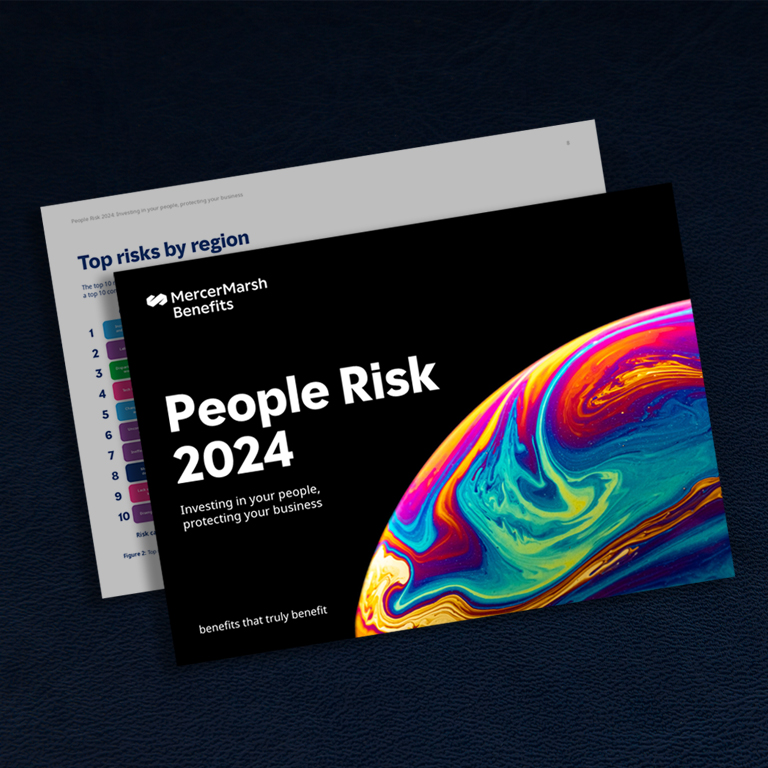
David Rahr
Global Leader, Marsh Multinational
The people who power any company are its most critical asset. But unless business leaders put the right processes in place to properly hire, onboard, develop, and manage their people, they may be missing a critical opportunity to help both their employees and organisations succeed.
For multinational companies whose risks span cultures, countries, and compliance environments, it has never been more important to look at people risk through a global lens, identify threats to employee health and wellbeing, and develop actionable ways to mitigate these risks.
However, to do so effectively, people risk should be addressed as a cross-collaborative effort, rather than siloed within individual departments, like human resources (HR) or risk management. When talent and risk leaders work together to address people risk, they can empower a more productive workforce, encourage talent development and retention, and build more resilient companies — with more successful leaders at the forefront.
People risk encompasses any business risk generated by your workforce and the way you manage, equip, and motivate them. Common people risks could be related to:
However, people risk is increasingly intertwined with other global risks that may not have been previously considered employee-related. For example, the Global Risks Report 2024, produced by the World Economic Forum in partnership with Marsh McLennan and others, outlines several risk categories that may inevitably have an impact on people and their performance at work.
For example, climate-related events, like heatwaves, floods, and wildfires, which were traditionally viewed as property risks, could impact employee health in several ways, including heat-related illnesses, respiratory health problems from smoke and poor air quality, or increased mental health challenges.
An aging workforce is also contributing to long-term health concerns, as well as potentially deepening labor shortages. Additionally, organisations may face a loss of expertise and industry knowledge that their older workers have cultivated during many years on the job. The compounding nature of these risks, left unaddressed, could have a detrimental impact on your people and business at large.
Whether they recognise it or not, talent leaders and risk managers are both equally invested in addressing people risk. Despite some leaders perceiving a separation between the two functions, the People Risk Report 2024, published earlier this year by Marsh and Mercer and based on insights from HR and risk professionals across 25 countries, demonstrates that they share similar priorities: attracting and retaining talent is a leading concern for companies globally.
However, organisational complexity, lack of skills or resources, ineffective communication, and other factors could hinder organisations’ ability to address these risks in a cross-collaborative way. Now and into the future, senior leaders should evaluate their structure and break down any barriers that might be blocking HR and risk leaders from developing stronger, more unified responses to their most pressing people risks. Some of their top, collaborative priorities should include the following:
It is essential that leaders strive to protect and address the needs of their employees, especially as mental health challenges become more prevalent. According to Marsh Mercer Benefits’ 2023 Health on Demand report, close to 50% of employees surveyed report feeling stressed; work pressures, poor leadership, and a toxic culture were the top reasons employees reported burnout. This calls for further emphasis on physical and emotional safety at work, whether employees are driving a truck, operating heavy machinery, or working at an office.
As outlined in the People Risk Report 2024, workforce mental health issues, including stress, depression, anxiety, and burnout, can lead to sub-optimal productivity, safety concerns, increased absenteeism, and loss of talent. Talent leaders and risk managers can work together to introduce mental health benefits, support resources, and counseling services to promote a culture of psychological safety and empathy, in turn helping to create a safer work environment overall.
Defining an employee experience that supports talent acquisition and retention strategies is a core part of mitigating people risks. However, HR leaders responding to Mercer’s Global Talent Trends Study 2024 estimate a 19% global employee turnover rate this year. Uncompetitive talent strategies were also listed as a top three risk in the People Risk Report. For many leaders, their biggest concern is being able to secure specialised skills to drive innovation and deliver services.
Addressing this challenge requires empowering employees with the skills they need to learn and continue growing as professionals and people. Upskilling offers employees the abilities they need to perform better in their current roles, reskilling equips them with the capabilities for new roles, and career planning helps empower the existing workforce for their next step. According to 69% of C-suite respondents to the People Risks Report 2024, training and up/reskilling will enhance productivity. Better yet, employees who report that their organisation provides them with the skills they need to succeed are nearly 50% more committed to their organisation.
Globally, talent and risk leaders ranked tech skill shortages as their fourth highest concern, with 44% of respondents worried about the increased risk of cyberattacks due to lack of cybersecurity awareness among employees, organisational design, and/or culture.
While tech advancements may be exciting, potentially leading to increased efficiencies, they may increase exposure to cyber risks. Considering the potential impacts of a cyber event, organisations need to prepare people with the education and tools they need to embrace the best parts of new technology while remaining attentive to its inherent risks. Risk managers and talent leaders can tag team to build education and training into onboarding, as well as regular educational sessions and opportunities.
Any business is only as successful as the people who show up to work every day. Regardless of the challenges ahead, protecting your employees and supporting their growth will always be paramount to their individual success as well as that of your organisation.
Talent leaders and risk professionals sit at the intersection of all people risks, particularly multinational companies that are navigating a host of broader, global risks. By collaborating to address these overlapping challenges, they can enhance their business’ ability to attract excellent talent, nurture people’s skills and retain critical expertise and knowledge, and build long-term business resilience.

Global Leader, Marsh Multinational

Commercial Leader, MMB Multinational

Report
23/04/2024